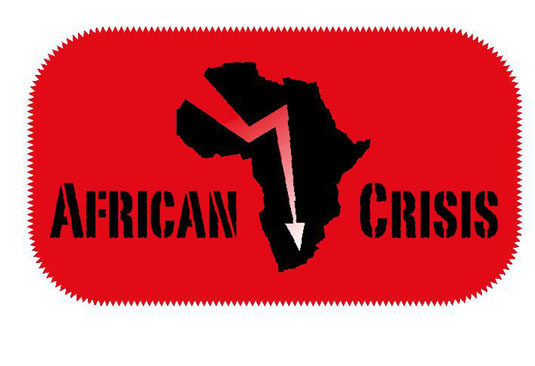WARNING: This is Version 1 of my old archive, so Photos will NOT work and many links will NOT work. But you can find articles by searching on the Titles. There is a lot of information in this archive. Use the SEARCH BAR at the top right. Prior to December 2012; I was a pro-Christian type of Conservative. I was unaware of the mass of Jewish lies in history, especially the lies regarding WW2 and Hitler. So in here you will find pro-Jewish and pro-Israel material. I was definitely WRONG about the Boeremag and Janusz Walus. They were for real.
Original Post Date: 2003-11-26 Posted By: Jan
From the News Archives of: WWW.AfricanCrisis.Org
Date & Time Posted: 11/26/2003 6:39:19 AM
Countdown to extinction for world"s great apes
[Note. People outside Africa do not realise how Africa’s ecology has been ruined in recent decades through the spread of poverty. People will kill, eat, sell, export anything… Many of Africa’s major species are facing exinction in the not too distant future. Jan]
Gorillas, chimpanzees, bonobos and orangutans — the closest living relatives of humanity — could vanish from the wild within 50 years, say United Nations leaders meeting today in Paris. They have appealed for $25-million to save the world’s great apes from extinction.
“The clock is standing at one minute to midnight for the great apes, animals that share more than 96% of their DNA with humans,” said Klaus Te(182)¶pfer, the head of the UN environment programme. “If we lose any great ape species we will be destroying a bridge to our own origins, and with it part of our own humanity.” He called the $25-million “the bare minimum we need, the equivalent of providing a dying man with bread and water”.
The UN first sounded an alarm about the rapidly dwindling numbers of great apes in 2001 and appealed for funds. But by last year, researchers on the ground had begun to reveal an even more ominous pattern of loss. They found that ape numbers in Africa had been slashed by logging, hunting and disease.
In one population studied, researchers knew of 140 gorillas. After an outbreak of the Ebola virus, they could only find seven alive. “The stark truth is that if we do not act decisively, our children may live in a world without wild apes,” they reported.
To survive and breed, great apes need undisturbed forest. The western chimpanzee has vanished from Benin, Gambia and Togo. Fewer than 400 remain in Senegal and 300 to 500 in Ghana. The population of chimps in Guinea-Bissau is below 200. Only about 600 mountain gorillas survive in Uganda, Rwanda and the Democratic Republic of Congo.
By 2030, less than 10% of Africa’s remaining forest is likely to remain undisturbed. The picture from south-east Asia is also bleak: by 2030, there will be almost no habitat that could be described as “relatively undisturbed”.
UN agencies, conservation organisations, donor countries and officials from 23 African and south-east Asian nations have been meeting in Paris to work on survival strategies. Researchers have begun to use European satellite studies to measure forest destruction, and Unesco officials are working to improve law enforcement in African national parks.
“We cannot just put up fences to try and separate the apes from people,” said Samy Mankoto of Unesco. “Great apes play a key role in maintaining the health and diversity of tropical forests, which people depend on. They disperse seeds throughout the forests, for example, and create light gaps in the forest canopy which allow seedlings to grow and replenish the forest ecosystem.”
Rob Hepworth of Unep said “It’s basic arithmetic: the multiplication of threats to the great apes, the division of their habitats, the subtraction of overall ape numbers.”
To get the sums right, he added, would take the combined efforts of two UN agencies, four wildlife conventions, and 18 non-governmental organisations to raise awareness, funds and “our conservation game to stop the great apes becoming history”.
Our closest relatives in danger
Gorilla
Lowland and mountain gorillas range through nine African countries. There are no reliable figures — but one estimate suggests 80% to 90% of the population may have been lost in just five years, as new roads have opened up inaccessible forest to poachers, loggers and bushmeat hunters.
Chimpanzee
Two species, Pan troglodytes and Pan paniscus (the bonobo or pigmy chimpanzee) range through 21 African countries. There could be 105 000 Pan troglodytes, and fewer than 20 000 bonobos left. Chimpanzee DNA is so close to human DNA that one scientist has proposed that they should be reclassified as genus Homo.
Orangutan
Pongo pygmaeus, found in Sumatra, Borneo and Sarawak. Total numbers are unknown — but the species is at “extremely high risk” of extinction in Sumatra where a population put at 6 000 three years ago has been falling by 1 000 a year. It is also endangered in Borneo. Greatest threats: logging and forest fire. –
Guardian Unlimited (194)Â Guardian Newspapers Limited 2003
URL: http://www.mg.co.za/Content/l3.asp?ao=24060br>
